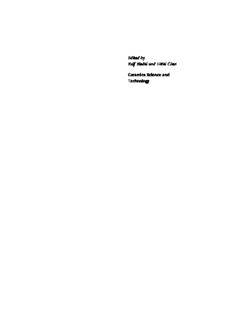Table Of ContentEdited by
Ralf Riedel and I-Wei Chen
Ceramics Science and
Technology
Related Titles
Riedel, R./Chen, I-W.(eds.) Riedel, R.,Chen,I-W. (eds.)
Ceramics Science and Ceramics Science and
Technology Technology
Volume2:MaterialsandProperties Volume1:Structures
2010 2008
ISBN:978-3-527-31156-9 ISBN:978-3-527-31155-2
Heimann, R.B. Krenkel, W.(ed.)
Classic and Advanced Ceramics Ceramic Matrix Composites
FromFundamentalstoApplications FiberReinforcedCeramicsand
theirApplications
2010
ISBN:978-3-527-32517-7 2008
ISBN:978-3-527-31361-7
Aldinger,Fritz /Weberruss, Volker A.
Öchsner,A.,Murch, G. E.,de Lemos,
An Introduction to Structures,
M. J.S.(eds.)
Properties, Technologies,
Cellular and Porous Materials
Methods
ThermalPropertiesSimulationand
2010
Prediction
ISBN:978-3-527-32157-5
2008
Ghosh, S.K.(ed.) ISBN:978-3-527-31938-1
Self-healing Materials
Fundamentals,DesignStrategies,
andApplications
2009
ISBN:978-3-527-31829-2
Edited by
Ralf Riedel and I-Wei Chen
Ceramics Science and
Technology
TheEditors AllbookspublishedbyWiley-VCHarecarefully
produced.Nevertheless,authors,editors,and
Prof.Dr.RalfRiedel publisherdonotwarranttheinformationcontained
TUDarmstadt inthesebooks,includingthisbook,tobefreeof
InstitutfürMaterialwissenschaft errors.Readersareadvisedtokeepinmindthat
Petersenstr.32 statements,data,illustrations,proceduraldetailsor
64287Darmstadt otheritemsmayinadvertentlybeinaccurate.
Germany
LibraryofCongressCardNo.: appliedfor
Prof.Dr.I-WeiChen
BritishLibraryCataloguing-in-PublicationData
UniversityofPennsylvania
Acataloguerecordforthisbookisavailablefromthe
SchoolofEngineering
BritishLibrary.
3231WalnutStreet
Philadelphia,PA19104-6272
Bibliographicinformationpublishedby
USA
theDeutscheNationalbibliothek
TheDeutscheNationalbibliothekliststhispublica-
tionintheDeutscheNationalbibliografie;detailed
bibliographicdataareavailableontheInternetat
http://dnb.d-nb.de.
#2012Wiley-VCHVerlag&Co.KGaA,
Boschstr.12,69469Weinheim,Germany
Allrightsreserved(includingthoseoftranslation
intootherlanguages).Nopartofthisbookmaybe
reproducedinanyform–byphotoprinting,
microfilm,oranyothermeans–nortransmittedor
translatedintoamachinelanguagewithoutwritten
permissionfromthepublishers.Registerednames,
trademarks,etc.usedinthisbook,evenwhennot
specificallymarkedassuch,arenottobeconsidered
unprotectedbylaw.
Composition ThomsonDigital,Noida,India
PrintingandBinding betz-druckGmbH,Darmstadt
CoverDesign SchulzGrafik-Design,Fußgönheim
PrintedintheFederalRepublicofGermany
Printedonacid-freepaper
PrintISBN: 978-3-527-31157-6
ePDFISBN:978-3-527-63196-4
oBookISBN: 978-3-527-63195-7
V
Contents
Preface XV
List of Contributors XVII
PartI Powders 1
1 PowderCompactionbyDryPressing 3
RainerOberacker
1.1 Introduction 3
1.2 FundamentalAspectsofDryPressing 3
1.2.1 DieorMoldFillingBehaviorofPowders 4
1.2.1.1 ParticlePacking:AStaticView 5
1.2.1.2 PracticalAspectsofDieFillingWithGranulates 7
1.2.2 CompactionBehavior 8
1.2.2.1 CompactionofMonolithicPowders 8
1.2.2.2 CompactionofGranulatedPowders 10
1.2.2.3 UnderstandingPowderCompactionbyAdvancedModeling 14
1.3 PracticeofUniaxialCompaction 19
1.3.1 DieFilling 19
1.3.2 ToolingPrinciplesandPressingTools 21
1.3.3 PowderCompactionPresses 23
1.4 PracticeofIsostaticCompaction 25
1.4.1 Wet-BagIsostaticPressing 25
1.4.2 Dry-BagIsostaticPressing 28
1.5 GranulationofCeramicPowders 29
1.5.1 Spray-Drying 30
1.5.2 AlternativeSprayGranulationMethods 33
1.5.3 CharacterizationofCeramicGranulates 34
References 34
2 TapeCasting 39
AndreasRoosen
2.1 UseoftheTapeCastingProcess 39
2.2 ProcessVariations 41
VI Contents
2.3 TapeCastingProcess 42
2.4 ComponentsoftheSlurry 44
2.4.1 InorganicRawMaterials 45
2.4.2 Solvents 46
2.4.3 OrganicRawMaterials 47
2.4.3.1 DispersingAgents 47
2.4.3.2 BinderandPlasticizer 48
2.4.3.3 OtherAdditives 49
2.4.4 InteractionbetweenSlurryComponents 50
2.5 PreparationoftheSlurryanditsProperties 51
2.6 TapeCasting 52
2.6.1 DryingandCharacteristicsoftheGreenTape 54
2.7 Machining,Metallization,andLamination 55
2.8 BinderBurnout 56
2.9 Firing 56
2.10 Summary 58
References 58
3 HydrothermalRoutestoAdvancedCeramicPowders
andMaterials 63
WojciechL.SuchanekandRichardE.Riman
3.1 IntroductiontoHydrothermalSynthesis 63
3.1.1 FundamentalDefinitions 63
3.1.2 ProcessDevelopmentandIndustrialProduction 65
3.1.3 HydrothermalHybridTechniques 67
3.1.4 PhysicalandChemicalAdvantagesofHydrothermalSolutions 68
3.2 EngineeringCeramicSynthesisinHydrothermalSolution 69
3.2.1 PhasePartitioninginHydrothermalSystems 69
3.2.2 ARationalApproachforEngineeringHydrothermalSynthesis
Methods 69
3.2.3 ThermodynamicModeling 70
3.2.4 ExamplesofSynthesisEngineering 72
3.3 MaterialsChemistryofHydrothermalCeramicPowders 74
3.3.1 ControlofChemicalComposition 74
3.3.2 PhysicalCharacteristicsandtheirControl 77
3.4 CeramicsProcessedfromHydrothermallySynthesized
Powders 80
3.4.1 SynthesisofModifiedPowdersforEnhancedSinterability 80
3.4.2 PowdersforSinteredDenseCeramicswithFineGrainSize 81
3.4.3 SinteredPorousCeramicsfromHydrothermallySynthesized
Powders 85
3.4.4 FabricationofTexturedCeramicsfromHydrothermalPowders 86
3.4.5 In-SituHydrothermalConversionandHydrothermalSintering 87
3.5 Summary 88
References 88
Contents VII
4 LiquidFeed-FlameSprayPyrolysis(LF-FSP)intheSynthesis
ofSingle-andMixed-MetalOxideNanopowders 97
RichardM.Laine
4.1 Introduction 97
4.2 BasicConceptsofNanopowderFormationDuringLF-FSP 100
4.2.1 ParticleSizeDistributions 101
4.2.2 PhaseFormation 102
4.2.3 PhaseCharacterization 103
4.3 CanNanoparticlesBePreparedThatConsistofMixedPhases? 104
4.3.1 TheTiO2/Al2O3System 104
4.3.2 ChangingBandGaps 107
4.4 WhichParticleMorphologiesCanbeAccessed? 107
4.5 CanNanopowdersBeDoped? 110
4.5.1 Sinter-ResistantMaterials 110
4.5.2 LaserPaints 111
References 116
5 Sol–GelProcessingofCeramics 121
NicolaHüsing
5.1 Introduction 121
5.2 PrinciplesofSol–GelProcessing 122
5.3 PorousMaterials 126
5.4 HybridMaterials 130
5.5 BioactiveSol–GelMaterials 133
5.5.1 In-SituEncapsulationofBiomolecules 133
5.5.2 BioactiveMaterials 136
References 137
PartII DensificationandBeyond 141
6 Sintering 143
Suk-JoongL.Kang
6.1 SinteringPhenomena 143
6.2 Solid-StateSintering 144
6.2.1 SinteringModelsandKineticswithNoGrainGrowth 144
6.2.1.1 InitialStageModelandKinetics 145
6.2.1.2 IntermediateandFinalStageModelsandKinetics 148
6.2.1.3 GrainBoundaryStructureandDensificationKinetics 150
6.2.2 GrainGrowth 150
6.2.2.1 NormalGrainGrowth 151
6.2.2.2 GrainGrowthinthePresenceofSecond-PhaseParticles 152
6.2.2.3 GrainGrowthwithBoundarySegregation 152
6.2.2.4 GrainGrowthBehaviorwithBoundaryStructure 154
6.2.3 MicrostructureDevelopment 155
6.3 Liquid-PhaseSintering 156
VIII Contents
6.3.1 DensificationModelsandTheories 157
6.3.1.1 ContactFlattening 159
6.3.1.2 PoreFilling 159
6.3.2 GrainGrowth 161
6.3.3 MicrostructureDevelopment 163
6.4 Summary 164
References 165
7 HotIsostaticPressingandGas-PressureSintering 171
MichaelJ.Hoffmann,StefanFünfschilling,andDenizKahraman
7.1 Introduction 171
7.2 SinteringMechanismswithAppliedPressure 172
7.3 SiliconNitrideCeramics:ComparisonofCapsuleHIP
andSinter-HIPTechnology 175
7.3.1 CapsuleHIP 176
7.3.2 Sinter-HIP 177
7.3.3 DifferencesbetweenCapsule-HIPandSinter-HIP 181
7.4 OtherApplications 182
7.4.1 StructuralCeramics 182
7.4.2 Post-HIPingofOxideCeramicsforOptical
Applications 182
References 185
8 HotPressingandSparkPlasmaSintering 189
MatsNygrenandZhijianShen
8.1 Introduction 189
8.2 AdvantagesofSinteringUnderaUniaxialPressure 190
8.3 ConventionalHotPresses 193
8.4 SPSSet-Up 194
8.5 UniqueFeaturesandAdvantagesoftheSPSProcess 196
8.6 TheRoleofHighPressure 197
8.7 TheRoleofRapidandEffectiveHeating 199
8.8 TheRoleofPulsedDirectCurrent 202
8.9 MicrostructuralPrototypingbySPS 203
8.9.1 NanoceramicsandCeramicsNanocomposites 203
8.9.2 Self-ReinforcedCeramics 205
8.9.3 SuperplasticityandTexturedCeramics 206
8.9.4 Non-EquilibriumCeramicComposites 208
8.9.5 CeramicswithMacro-andMicro-Graded
Structures 210
8.9.6 Hard-to-MakeCeramics 211
8.9.7 Defect-EngineeredCeramics 212
8.10 PotentialIndustrialApplications 213
References 213
Contents IX
9 FundamentalsandMethodsofCeramicJoining 215
K.ScottWeil
9.1 Introduction 215
9.2 BasicPhenomenainCeramicJoining 216
9.2.1 Mechanics 216
9.2.1.1 TheStrengthofCeramics 216
9.2.1.2 ContactStress 217
9.2.1.3 ResidualStress 217
9.2.1.4 ElasticModulusEffects 219
9.2.1.5 OtherEffects 220
9.2.1.6 StrengthofBondedJoints 220
9.2.2 AdhesionandWetting 221
9.2.3 Diffusion 224
9.2.4 ChemicalReaction 225
9.3 MethodsofJoining 227
9.3.1 MechanicalJoining 227
9.3.2 DirectBonding 231
9.3.2.1 Solid-StateDirect-BondingProcesses 231
9.3.2.2 Liquid-StateDirect-BondingProcesses 234
9.3.3 InterlayerBonding 235
9.3.3.1 Solid-StateInterlayerBondingProcesses 235
9.3.3.2 Liquid-StateInterlayerBondingProcesses 237
9.4 Conclusions 243
References 243
10 MachiningandFinishingofCeramics 247
EckartUhlmann,GregorHasper,ThomasHoghé,ChristophHübert,
VanjaMihotovic,andChristophSammler
10.1 Introduction 247
10.2 FaceandProfileGrinding 248
10.2.1 ProcessDescription 248
10.2.2 MachiningofCeramics 250
10.3 CurrentStatusandFutureProspects 251
10.4 Double-FaceGrindingwithPlanetary
Kinematics 252
10.4.1 ProcessDescription 252
10.4.2 MachiningofCeramics 254
10.4.3 CurrentStatusandFutureProspects 255
10.5 Ultrasonic-AssistedGrinding 256
10.5.1 ProcessDescription 256
10.5.2 MachiningofCeramics 256
10.5.3 CurrentStatusandFutureProspects 258
10.6 AbrasiveFlowMachining 261
10.6.1 ProcessDescription 261
10.6.2 MachiningofCeramics 263
X Contents
10.6.3 CurrentStatusandFutureProspects 263
10.7 Outlook 264
References 265
PartIII FilmsandCoatings 267
11 Vapor-PhaseDepositionofOxides 269
LambertAlff,AndreasKlein,PhilippKomissinskiy,
andJoseKurian
11.1 Introduction 269
11.1.1 SputterDeposition 270
11.1.2 Pulsed-LaserDeposition 275
11.1.3 OxideMolecularBeamEpitaxy 282
11.2 Summary 289
References 289
12 Metal–OrganicChemicalVaporDepositionofMetalOxide
FilmsandNanostructures 291
SanjayMathur,AadeshPratapSingh,RalfMüller,TessaLeuning,
ThomasLehnen,andHaoShen
12.1 Introduction 291
12.2 MetalOxideFilmDeposition 300
12.2.1 PhysicalandChemicalVaporDepositionTechniques 300
12.2.2 ChemicalVaporDeposition 302
12.2.2.1 ThermallyActivatedCVD(TA-CVD) 302
12.2.2.2 Plasma-EnhancedCVD(PE-CVD) 303
12.2.2.3 Molecule-BasedCVD(MB-CVD) 304
12.2.3 AtomicLayerDeposition 304
12.2.4 GrowthDynamics 308
12.2.4.1 AmorphousGrowth 309
12.2.4.2 EpitaxialGrowth 309
12.2.4.3 PolycrystallineGrowth 309
12.2.5 MechanisticAspectsofCVD 310
12.3 ThePrecursorConceptinCVD 313
12.3.1 PrecursorRequisites 313
12.3.2 Precursor–MaterialRelationship 314
12.3.3 InfluenceofPrecursorFlowRateonMicrostructure
andGrowth 320
12.4 MetalOxideCoatings 321
12.4.1 MonometallicPrecursor(MOx)Systems 321
12.4.2 BimetallicPrecursor(MMOx)Systems 324
12.4.3 Composites(MOx/MOy)Systems 326
12.5 Summary 327
References 330
Description:From the Back Cover Although ceramics have been known to mankind literally for millennia, research has never ceased. Apart from the classic uses as a bulk material in pottery, construction, and decoration, the latter half of the twentieth century saw an explosive growth of application fields, such a

